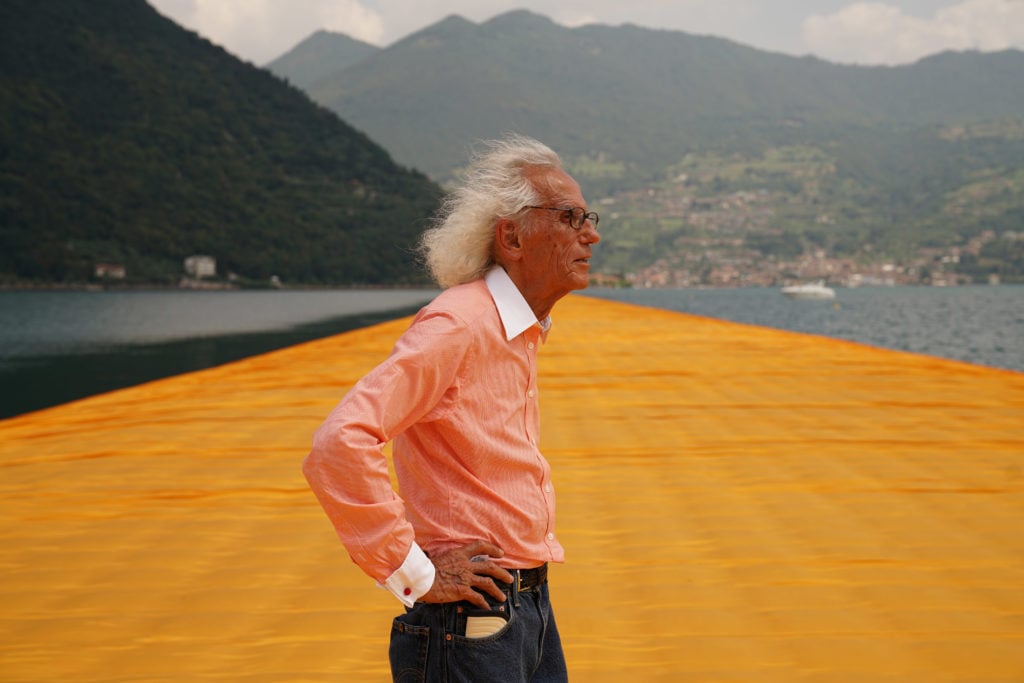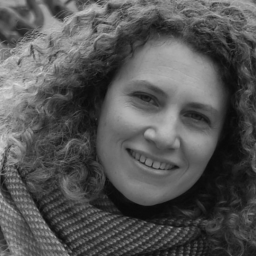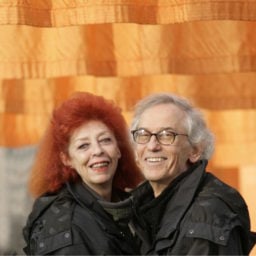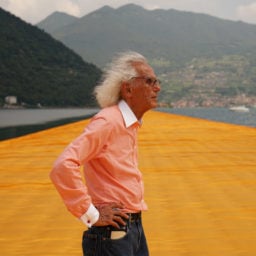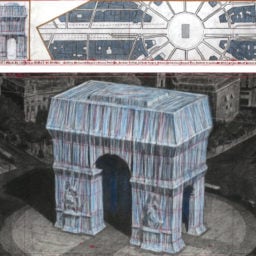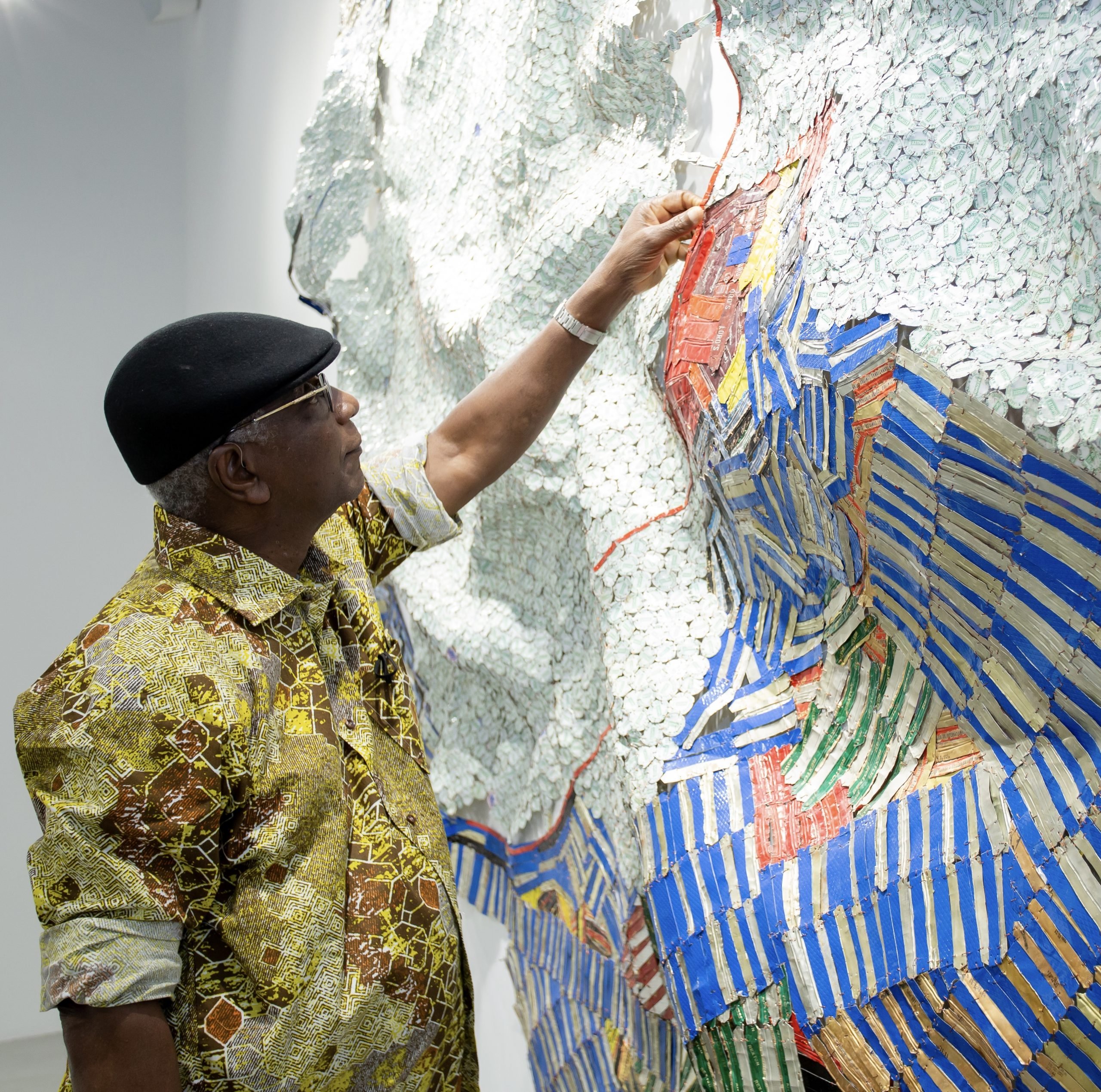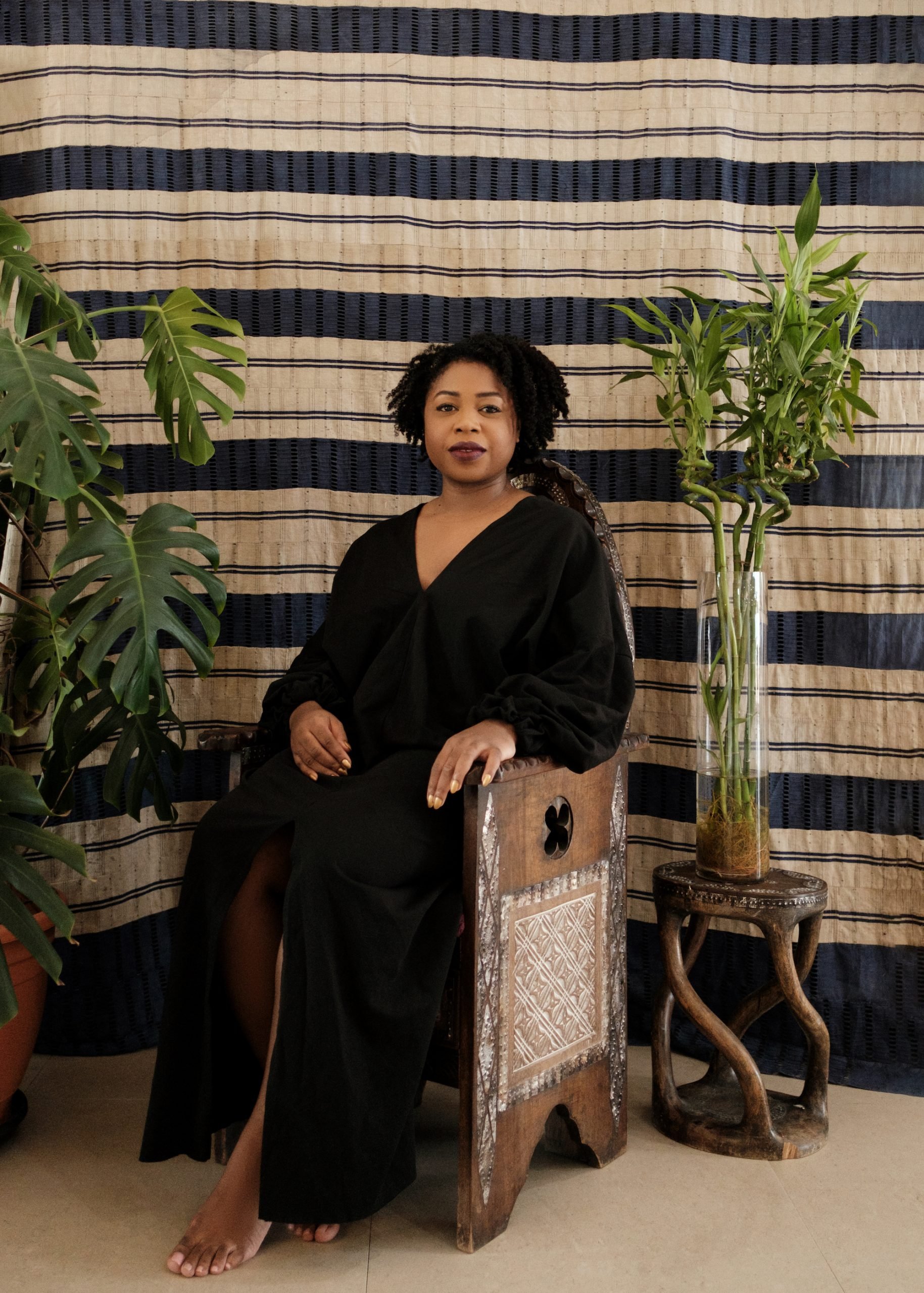He can slip from people’s minds, and years may pass between the realization of major works. But in one way or another, most corners of the planet have been touched by the remarkably talented hand of Christo.
The Bulgarian-born artist Christo Vladimirov Javacheff has spent more than 50 years making spectacular temporary fabric-wrapped monuments that have captivated imaginations the world over. But he says he never thinks about the impact he has on the younger generations of artists. It’s a modest reply from someone whose legacy is as formidable as his: Christo was among the first to abandon the traditional gallery space and take his art to far-flung places ranging from the Australian coastline to the German parliament. He draped curtains across valleys, floated them over islands, and weaved them around bridges—nothing seemed unconquerable.
But he’s not particularly interested in recounting the past. “I don’t like to look back,” he tells me at his home in SoHo.
Still, he is going to anyway—although it’s unclear when. The opening of the Centre Pompidou’s exhibition “Christo & Jeanne-Claude, Paris!” dedicated to the artist and his late collaborator wife, has been indefinitely postponed due to the ongoing global health situation. Nevertheless, Christo is still swamped with work. If all goes well, the Pompidou’s “ghost show,” as the French press has now dubbed it, will be topped off with one of the most anticipated public art events of the year: Christo wrapping the Arc de Triomphe between September 19 and October 4.

Christo with his recent works in the courtyard of 4, avenue Raymond-Poincaré, Paris, 16th arr., 1962. © Christo 1962. Photo © Shunk-Kender. © J. Paul Getty Trust. Getty Research Institut, Los Angeles.
The Nomad
Despite his professed antipathy for retrospection, Christo does reminisce throughout our animated discussion. We meet in a casual reception room inside the multi-story building he has owned since 1964 and used to share with his wife. He calls it the “brain of the project,” referring to all of the major artworks he and Jeanne-Claude conceived and produced there. Christo charismatically bubbles over with information about his life and work in broken English mixed with a spattering of French and—despite being in poor health—little regard for the passing time.
Alternating between bellows and whispers, the 84-year-old’s eyes widen within his lanky frame as he refuses to answer simple questions with simple answers. After escaping communism in Bulgaria, a country behind the Iron Curtain at the time, Christo headed to Western Europe in 1957 by hiding in a freight car. It’s little wonder that he doesn’t bother with confines of any sort. He notes that, even today, he has not yet decided if he’s a painter, an architect, or whatever other word one might use to describe him.
Eventually he arrived in Paris, where he lived between 1958 and 1964. He survived there by painting portraits of socialites while making smaller, wrapped objects using fabric and twine in his spare time. (“I am an educated Marxist,” he says. “I use the capitalist system to the very end. It’s economical, clever, and it’s stupid not to do it.”)
It was in Paris where he met Jeanne-Claude Denat de Guillebon, who became his wife and collaborator until she died in 2009. Denat, who was commonly known as Jeanne-Claude, helped Christo scale up and realize larger projects; her spirit is alive in the Pompidou show, which covers these early Parisian years, including the duo’s wrapping of the Paris bridge Pont Neuf from 1985.
To understand Christo’s work, the former refugee says that he sees all the projects the two undertook over the years as ultimately marked by nomadism. “The cloth is the principal element to translate this,” he says. “The projects have many sturdy parts, but the fabric is very fast to install, like the tents of Bedouins in nomadic tribes.”
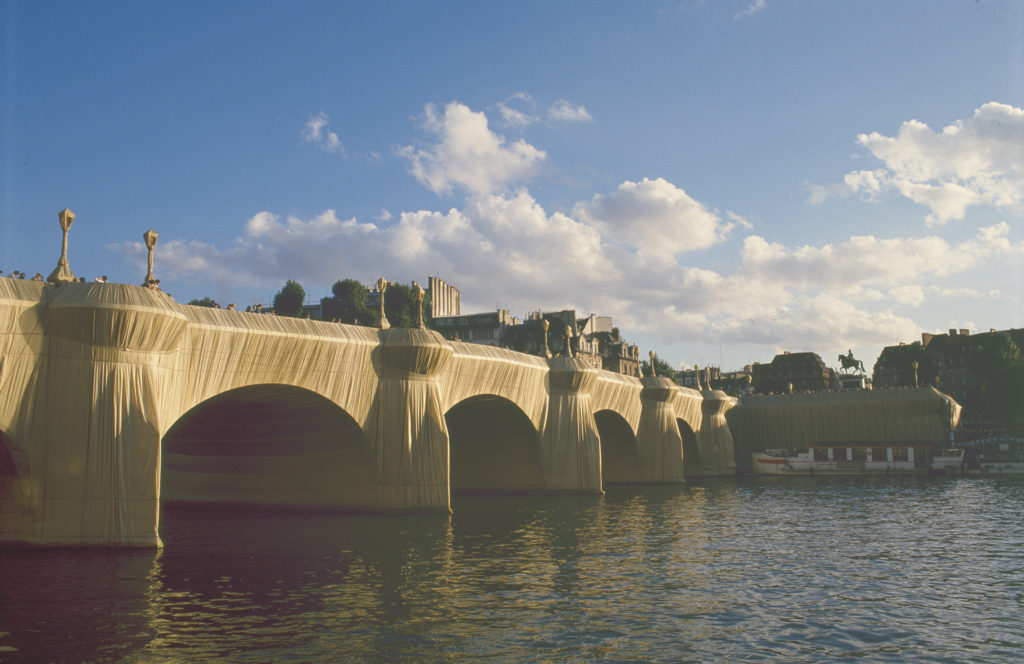
The Pont-Neuf Wrapped, Paris, 1975–85. © Christo 1985. Photo © Wolfang Volz.
Wrapping the Arc
On the periphery of several art movements like New Realism and Land Art, Christo’s reputation nevertheless began to grow when he illegally blocked the narrow rue Visconti street in Paris in 1962 with Wall of Oil Barrels – The Iron Curtain, a work consisting of 89 oil barrels stacked 4.3 meters (14 feet) high to protest against the building of the Berlin Wall. Years later, projects like The Gates, which was installed in Central Park in 2005, saw some 7,500 saffron-colored vinyl panels hung over the park’s walkways like an elevated river. Overnight, it made the duo world-famous.
Another gate of sorts, the Arc de Triomphe, will be transformed and remain only as an outline once it’s wrapped up this fall. “It’s built on a colline [hill], an elevation. This provides an enormous and unique perspective,” says Christo, who stands up, a bit short of breath, and points to details in one of his larger drawings of the monuments. “During the funeral of Victor Hugo, it was covered with black fabric, like a veil,” he says.
At the time of our meeting, Christo is furiously working to complete drawings of the new project site, sketches which hover between technical and architectural studies. “When you leave, I’m going upstairs to draw,” he tells me. “That is really the only place where I’m alone. I don’t see anybody [when I am] thinking how to solve.”
He does have some complex problem-solving to do. The Parisian archway will be veiled with 30,000 square meters (323,000 square feet) of recyclable polypropylene fabric in silvery blue, and 7,000 meters (23,000 feet) of red rope. The timing is planned to protect nesting falcons, and Christo is covering all costs, which are estimated to be upwards of €12 million ($13 million).
This “very important gate,” as Christo calls the Arc de Triomphe, is a project that he says he has been imagining since 1961 while living in a small maid’s room not far from the monument. He admits he “never expected” the project would ever come to fruition. “The site is so powerful. The Arc has an incredible light and history… It cannot be substituted,” he tells me. “We don’t just wrap things; we don’t wrap Eiffel Tower, or the Sacré Coeur. We wrap something profound.”
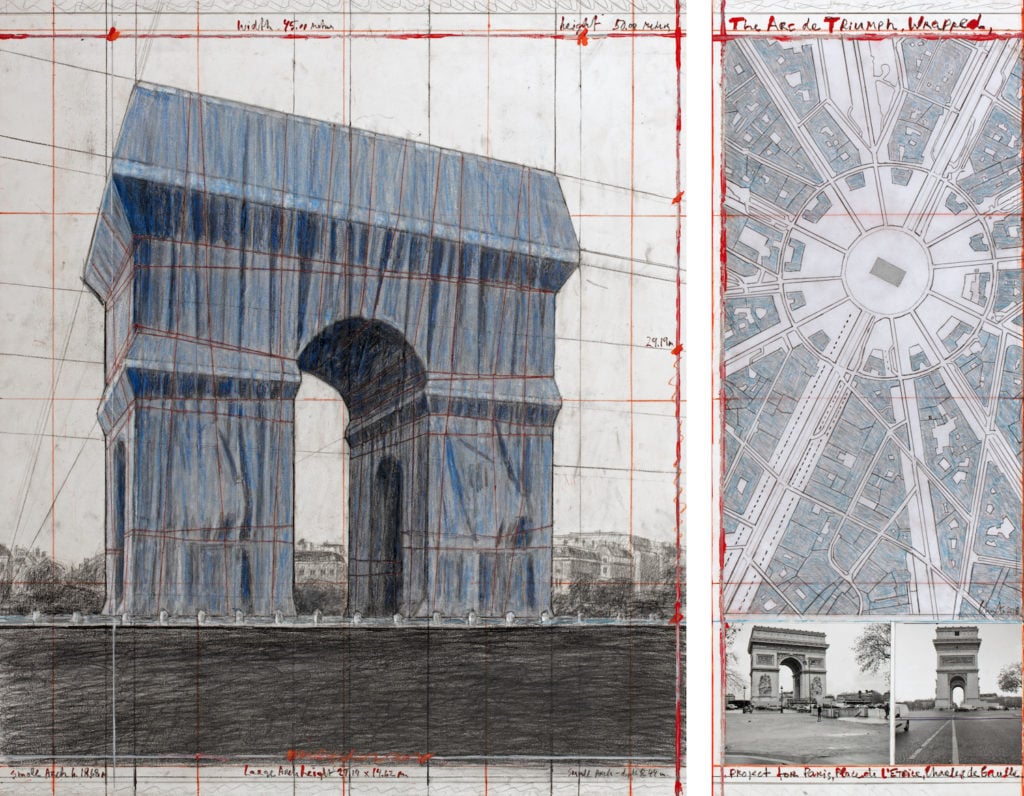
Christo The Arc de Triomphe, Wrapped, Project for Paris, Place de l’Etoile – Charles de Gaulle. Photo: André Grossmann. © 2018 Christo.
Real Life, Wrapped Up
Overt political messages, like his Iron Curtain of barrels, are rare for Christo. If a message comes across, that’s because, according to him, the works puncture the art-world bubble.
“The Reichstag was very political project, but I don’t do it for the politics. It’s not illustration of politics, it’s real politics; real debate in the parliament [over whether to permit the German parliament’s wrapping] … It’s not about filming water, it’s about the real water with real wind and real cold!” he says, adding that he cannot stand “television images, because they’re not real.”
These are not performances, he points out, though his final artworks are temporary events; they are instead sculptures that cannot be owned. In that regard, he thumbs his nose at the art market (at least, he does with respect to his grandiose final productions—preparatory drawings and materials from the productions have been for sale over the years through various galleries, which include mega-gallery Pace).

Christo and Jeanne-Claude, The London Mastaba, Serpentine Lake, Hyde Park (2016-18). Photo by Wolfgang Volz. © 2018 Christo.
Christo’s works require an outrageous investment of both time and money. First, he must gain building permission and set up independent financing schemes. The duo has always refused to work on commission; so Christo foots the bill by incorporating himself. “For each project we have thousand people who try to help us, and thousand people who try to stop us!” he cries.
That is particularly true for concerns about the environmental impact of his work. The political conversation has come a long way since Christo wrapped 2.4 kilometers (1.5 miles) of the Australian coast near Sidney with synthetic erosion control fabric in 1969. But in 2017, Christo delighted some animal-rights groups when he called off a planned project to suspend polypropylene fabric over nearly nine kilometers (six miles) of the Arkansas River in Colorado. Despite already having approval, Christo cancelled the project because he did not want to work with the country’s new “landlord,” Donald Trump.
Disasters have happened, too. A 485-pound umbrella from Christo’s 1991 project The Umbrellas flew out of its base and killed a woman in California. At the time, Christo expressed his sadness and said he would dedicate a book and film about the project to the victim, 34-year-old Lori Keevil-Mathews. A second death occurred during the removal of The Umbrellas piece from its second location in Japan, when a worker was electrocuted while manipulating a crane.
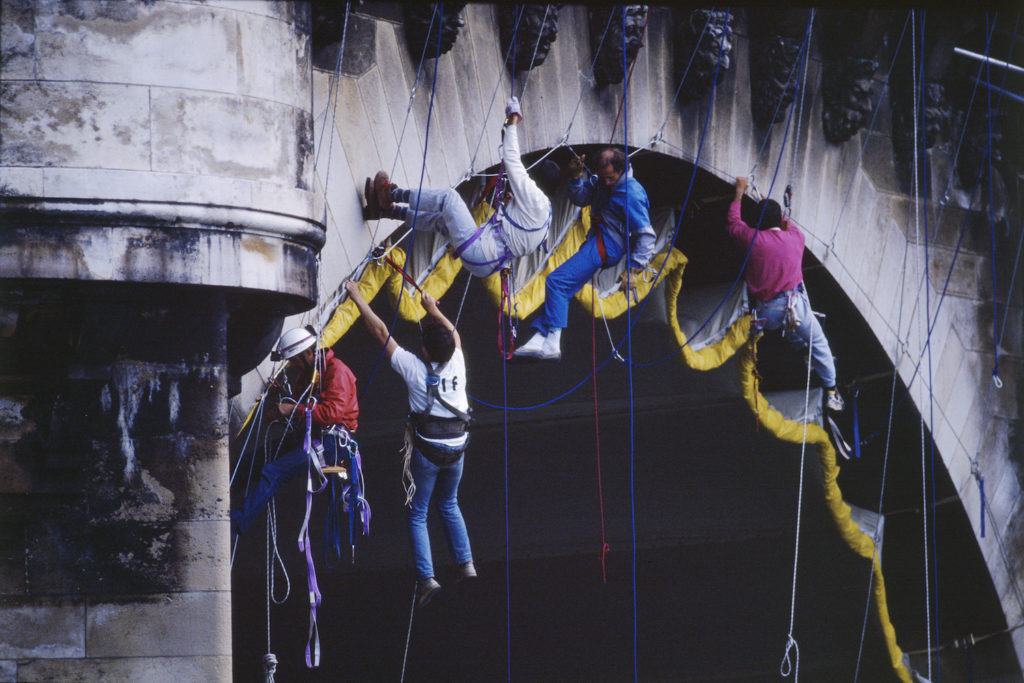
Climbers attach the fabric hoisted under one of the arches and adjust the tension of the straps sewn onto the fabric, making it hug the lines of the vault. © Christo 1985. Photo © Wolfang Volz.
Beyond horrible tragedies, public debate is nevertheless integral to Christo’s artistic endeavor. He insists that “the work of art is revealed through the process of gaining permission.” Many attempts have failed. Despite Jeanne-Claude’s skills as a fantastic negotiator, for the 23 projects made over 50 years, there were 47 that could not be realized.
Though most projects required years of jumping through bureaucratic hoops, the Arc de Triomphe plan was swiftly approved within about a year, “thanks to young president,” says Christo. But when asked if this was a sign of greater understanding and acceptance of his work in France, he interjects with an unequivocal no.
“All our projects are totally irrational, totally useless. Nobody needs them. The world can live without them. They exist in their time, impossible to repeat,” he says. “That is their power, because they cannot be bought, they cannot be possessed… They cannot be seen again.”
Considering his age, the latter may be true of his brilliant temporary craft in general. Nothing lasts forever. The Arc de Triomphe and ambitious endeavors like it could be among his final projects. Not that he shows any sign of slowing down too soon. The difficulty and the complexity he seems to endure now has always been a part of the beauty of his work. “We are not masochists,” he adds, still referring to Jeanne-Claude as his partner. “We would like the easy way, but the reality is, this is how it has to be done.”
Follow Artnet News on Facebook:
Want to stay ahead of the art world? Subscribe to our newsletter to get the breaking news, eye-opening interviews, and incisive critical takes that drive the conversation forward.
